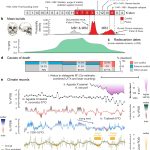Plant Science Research Weekly: July 29, 2022
A robust mechanism for resetting juvenility during each generation in Arabidopsis
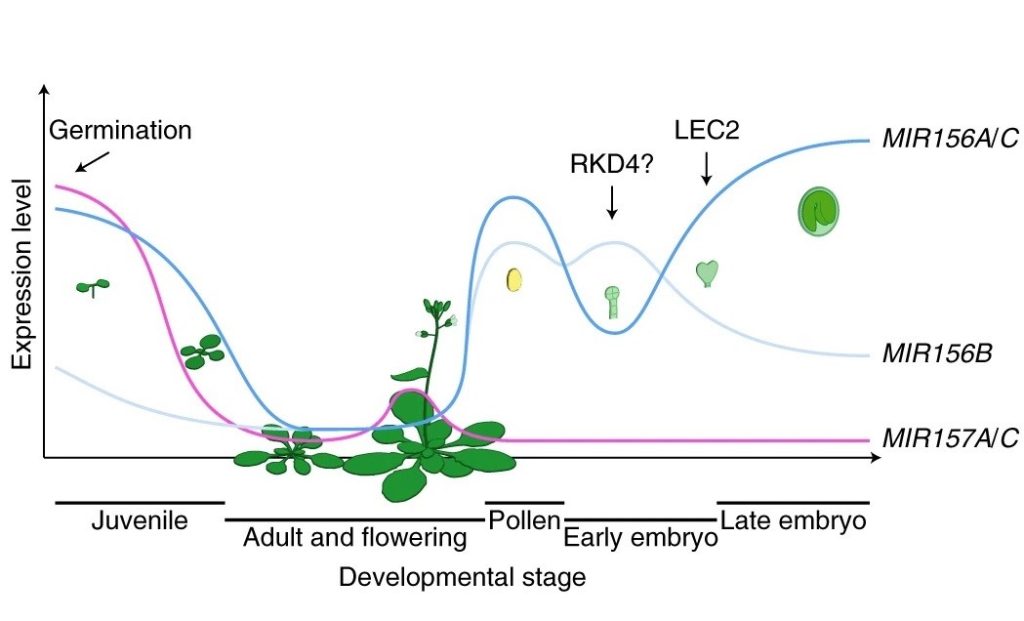 Proper development requires an aging program that is regulated throughout the entire lifespan of an organism as well as across generations. In plants, reproductive cells are derived from differentiated cells, and thus the aging program encoded in these reproductive cells must be rejuvenated per generation. So, how exactly is the cycling of this program controlled? In a data-rich paper, Gao et al. identified the microRNAs miR156 and miR157 (miR156/7) as the key molecular regulators in Arabidopsis thaliana. First, they showed that expression patterns of miR156/7 and the several functionally-redundant gene loci from which they are derived are suggestive of developmental programming, with MIR156A-C activation occurring during sexual reproduction and embryogenesis, and MIR157A/C levels resetting during germination. Studies performed with an impressive number of higher-level mutants (generated by CRISPR/Cas9) demonstrated the importance of MIR156/7 in the length of juvenility and the transitions into vegetative/sexual maturity, indicating their role in setting the plant’s developmental program. ATAC-seq performed on the most relevant genes, MIR156A-C and MIR157A/C, revealed variations in the accessibility of these different genes over time. MIR156A/C specifically demonstrated an accessibility patterning that was periodic by generation. The authors deemed the accessibility regulatory sequences of MIR156A/C as the “juvenility resetting region” (JRR). They further discovered a binding site in this JRR for LEAFY COTYLEDON2 (LEC2), an important transcription factor for embryogenesis. Through a combination of genetics, in vitro and in vivo binding assays, and inducible lines, they confirmed that MIR156A/C are both direct targets of LEC2, and that their LEC2-mediated activation is crucial for resetting plant juvenility. This work builds a molecular foundation for how plants regulate developmental programming over generations. (Summary by Benjamin Jin) Nature Plants, 10.1038/s41477-022-01110-4
Proper development requires an aging program that is regulated throughout the entire lifespan of an organism as well as across generations. In plants, reproductive cells are derived from differentiated cells, and thus the aging program encoded in these reproductive cells must be rejuvenated per generation. So, how exactly is the cycling of this program controlled? In a data-rich paper, Gao et al. identified the microRNAs miR156 and miR157 (miR156/7) as the key molecular regulators in Arabidopsis thaliana. First, they showed that expression patterns of miR156/7 and the several functionally-redundant gene loci from which they are derived are suggestive of developmental programming, with MIR156A-C activation occurring during sexual reproduction and embryogenesis, and MIR157A/C levels resetting during germination. Studies performed with an impressive number of higher-level mutants (generated by CRISPR/Cas9) demonstrated the importance of MIR156/7 in the length of juvenility and the transitions into vegetative/sexual maturity, indicating their role in setting the plant’s developmental program. ATAC-seq performed on the most relevant genes, MIR156A-C and MIR157A/C, revealed variations in the accessibility of these different genes over time. MIR156A/C specifically demonstrated an accessibility patterning that was periodic by generation. The authors deemed the accessibility regulatory sequences of MIR156A/C as the “juvenility resetting region” (JRR). They further discovered a binding site in this JRR for LEAFY COTYLEDON2 (LEC2), an important transcription factor for embryogenesis. Through a combination of genetics, in vitro and in vivo binding assays, and inducible lines, they confirmed that MIR156A/C are both direct targets of LEC2, and that their LEC2-mediated activation is crucial for resetting plant juvenility. This work builds a molecular foundation for how plants regulate developmental programming over generations. (Summary by Benjamin Jin) Nature Plants, 10.1038/s41477-022-01110-4
Improving bread wheat yield through modulating an unselected AP2/ERF gene
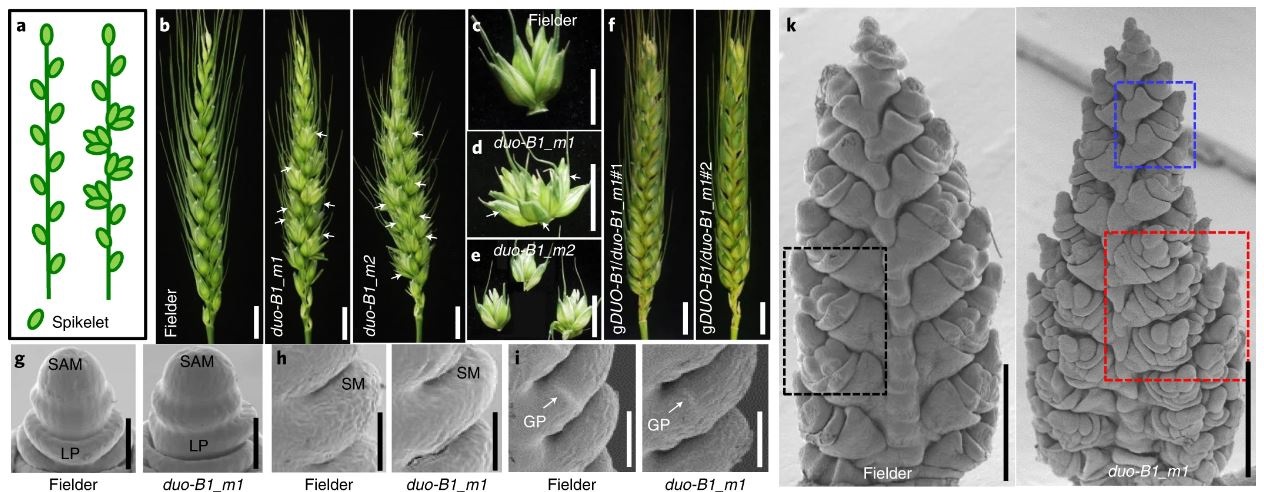 Climate emergency and the increase of human population are challenges for human food security. Plant breeders use natural genetic variation to improve crops, but bread wheat (Triticum aestivum L.) has particularly low genetic diversity with unique evolutionary constraints. Genetic modification of spike inflorescence architecture holds promise for increasing cereal yield. Thus, it is interesting to search for genetic variants that form supernumerary spikelets. Wang et al. showed that modified alleles of the locus DUO-B1 are involved in enhancing yield potential, photosynthesis, and nutrient use efficiency. They first identified this gene in Brachypodium distachyon, where they described an increased number of spikelets in duo-1 mutant lines. They searched for its homologs in bread wheat and found that DUO-B1, with highest expression in spikes, was negatively correlated with grain number per spike. After several trials in greenhouses and field, the authors described that plants with duo-b1 mutations show enhanced yield by altered cell division, cytokinin signalling and meristem activity. Finally, by performing an RNA-Seq they showed how DUO-B1 modulates the expression of WFZP, an inflorescence regulatory gene. Taken together, these results pave the way to develop new breeding strategies that will increase productivity by changing inflorescence architecture. (Summary by Eva Maria Gomez Alvarez, @eva_ga96) Nature Plants. 10.1038/s41477-022-01197-9
Climate emergency and the increase of human population are challenges for human food security. Plant breeders use natural genetic variation to improve crops, but bread wheat (Triticum aestivum L.) has particularly low genetic diversity with unique evolutionary constraints. Genetic modification of spike inflorescence architecture holds promise for increasing cereal yield. Thus, it is interesting to search for genetic variants that form supernumerary spikelets. Wang et al. showed that modified alleles of the locus DUO-B1 are involved in enhancing yield potential, photosynthesis, and nutrient use efficiency. They first identified this gene in Brachypodium distachyon, where they described an increased number of spikelets in duo-1 mutant lines. They searched for its homologs in bread wheat and found that DUO-B1, with highest expression in spikes, was negatively correlated with grain number per spike. After several trials in greenhouses and field, the authors described that plants with duo-b1 mutations show enhanced yield by altered cell division, cytokinin signalling and meristem activity. Finally, by performing an RNA-Seq they showed how DUO-B1 modulates the expression of WFZP, an inflorescence regulatory gene. Taken together, these results pave the way to develop new breeding strategies that will increase productivity by changing inflorescence architecture. (Summary by Eva Maria Gomez Alvarez, @eva_ga96) Nature Plants. 10.1038/s41477-022-01197-9
ABA-INSENSITIVE1 activates ammonium transporter AMT1 in an ABA dependent manner
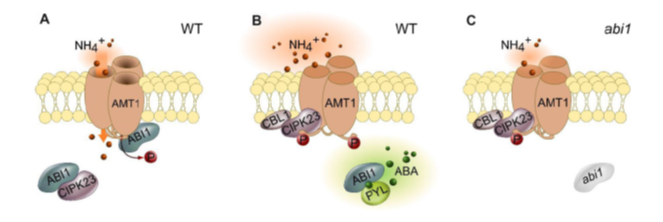 To avoid ammonium toxicity, the ammonium transporters (AMTs) are tightly regulated by phosphorylation-dependent inactivation. The multifunctional kinase CIPK23 inactivates the AMT1s by phosphorylating conserved threonine residues (T460 in AMT1;1 and T472 in AMT1;2). ABA-INSENSITIVE1 (ABI1) and ABI2 are members of clade A Protein Phosphatase 2 C, and core components of ABA signalling. ABI2 is a known regulator of nitrate uptake by its interaction with CIPK23, CBL1, and the dual affinity nitrate transceptor NPF6.3. Here, Ganz et al. report the prominent contribution of ABI1 in the post-translational regulation of AMT1 in an ammonium- and ABA-dependent manner. High levels of ammonium increase root ABA accumulation, possibly by promoting ABA de-glycosylation in the vacuole and endoplasmic reticulum. abi1-2 mutants are defective in ammonium uptake and are thus tolerant to high levels of ammonium. Similar to the abi1-2 mutants, high exogenous ABA supply also suppresses ammonium uptake. Under low ammonium conditions, ABI1 inactivates CIPK23, there by activating AMT1s. At high levels of ammonium, the increase in ABA content and the resultant robust ABA signalling inactivate ABI1, rendering CIPK23 active, which in turn phosphorylates and inactivates AMT1, decreasing ammonium uptake. (Summary by Lekshmy Sathee @lekshmysnair) Plant Physiol. 10.1093/plphys/kiac315
To avoid ammonium toxicity, the ammonium transporters (AMTs) are tightly regulated by phosphorylation-dependent inactivation. The multifunctional kinase CIPK23 inactivates the AMT1s by phosphorylating conserved threonine residues (T460 in AMT1;1 and T472 in AMT1;2). ABA-INSENSITIVE1 (ABI1) and ABI2 are members of clade A Protein Phosphatase 2 C, and core components of ABA signalling. ABI2 is a known regulator of nitrate uptake by its interaction with CIPK23, CBL1, and the dual affinity nitrate transceptor NPF6.3. Here, Ganz et al. report the prominent contribution of ABI1 in the post-translational regulation of AMT1 in an ammonium- and ABA-dependent manner. High levels of ammonium increase root ABA accumulation, possibly by promoting ABA de-glycosylation in the vacuole and endoplasmic reticulum. abi1-2 mutants are defective in ammonium uptake and are thus tolerant to high levels of ammonium. Similar to the abi1-2 mutants, high exogenous ABA supply also suppresses ammonium uptake. Under low ammonium conditions, ABI1 inactivates CIPK23, there by activating AMT1s. At high levels of ammonium, the increase in ABA content and the resultant robust ABA signalling inactivate ABI1, rendering CIPK23 active, which in turn phosphorylates and inactivates AMT1, decreasing ammonium uptake. (Summary by Lekshmy Sathee @lekshmysnair) Plant Physiol. 10.1093/plphys/kiac315
Allelic shift in cis-elements of the transcription factor gene RAP2.12 underlies adaptation associated with humidity in Arabidopsis thaliana
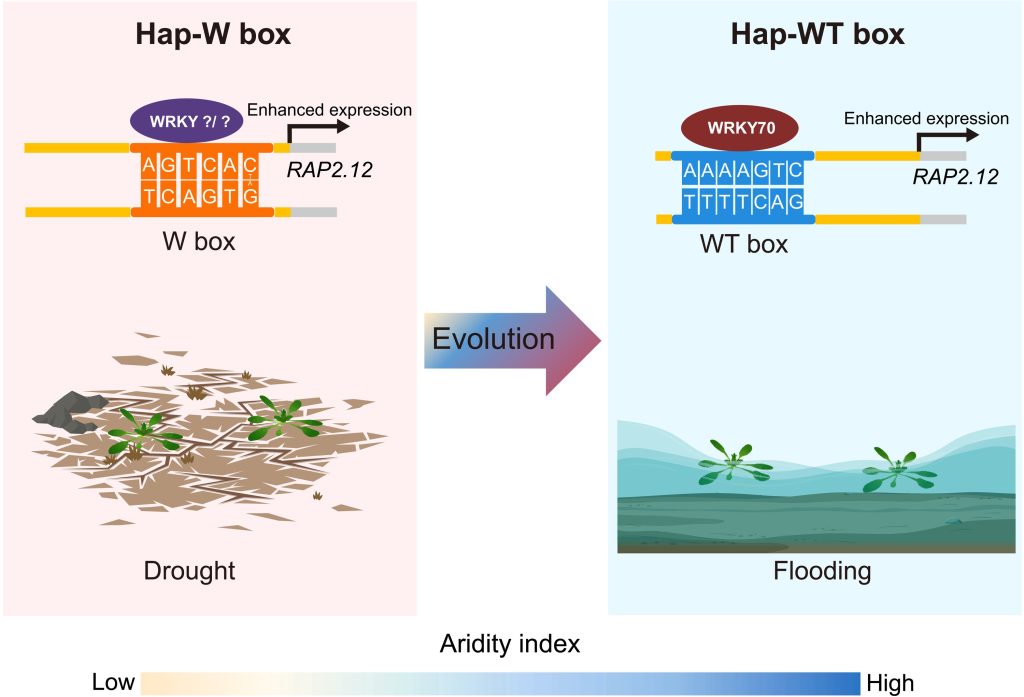 To better understand plant responses to different environments, Lou et al. compared Arabidopsis thaliana accessions derived from Sichuan (high precipitation/regular flooding) and Tibet (arid) to isolate genetic adaptations towards flooding stress. The two accessions showed divergent phenotypes: the Sichuan accession was able to recover much more effectively after submergence, while the Tibet accession could better survive drought. A GWAS with expression analysis revealed the RAP2.12 gene as the causal gene underlying flooding stress tolerance. RAP2.12 encodes a Group VII ETHYLENE RESPONSE FACTOR (ERFVII) which activates hypoxia-responsive genes. Although RAP2.12 derived from both accessions could activate flooding stress response, mRNA abundance of RAP2.12 was significantly higher in the Sichuan accession. Thus, the authors looked at the promoters of the two alleles. Promoter-Sichuan (pSic) accumulated RAP2.12 in hypoxic conditions at a higher rate than promoter-Tibet (pTib), and these promoters contain different cis-element sequences: pTib with a W box that can bind to WRKY transcription factors, and pSic with a WT box that is bound uniquely by WRKY70. WRKY70 is upregulated upon submergence, and WRKY70 acts specifically through the RAP2.12 alleles that have a WT box to induce submergence tolerance. Interestingly, under drought conditions, RAP2.12 is upregulated with pTib and downregulated with pSic. Ecological analysis suggested that arid and humid climates, leading to drought or hypoxic stresses respectively, were strong selective forces in accessional distribution of either WT or W boxes in RAP2.12, and further hint at A. thaliana’s evolutionary history as a plant originating in arid regions, later adapting to flooding stress after colonizing more humid lands. (Summary by Benjamin Jin) Science Advances 10.1126/sciadv.abn8281
To better understand plant responses to different environments, Lou et al. compared Arabidopsis thaliana accessions derived from Sichuan (high precipitation/regular flooding) and Tibet (arid) to isolate genetic adaptations towards flooding stress. The two accessions showed divergent phenotypes: the Sichuan accession was able to recover much more effectively after submergence, while the Tibet accession could better survive drought. A GWAS with expression analysis revealed the RAP2.12 gene as the causal gene underlying flooding stress tolerance. RAP2.12 encodes a Group VII ETHYLENE RESPONSE FACTOR (ERFVII) which activates hypoxia-responsive genes. Although RAP2.12 derived from both accessions could activate flooding stress response, mRNA abundance of RAP2.12 was significantly higher in the Sichuan accession. Thus, the authors looked at the promoters of the two alleles. Promoter-Sichuan (pSic) accumulated RAP2.12 in hypoxic conditions at a higher rate than promoter-Tibet (pTib), and these promoters contain different cis-element sequences: pTib with a W box that can bind to WRKY transcription factors, and pSic with a WT box that is bound uniquely by WRKY70. WRKY70 is upregulated upon submergence, and WRKY70 acts specifically through the RAP2.12 alleles that have a WT box to induce submergence tolerance. Interestingly, under drought conditions, RAP2.12 is upregulated with pTib and downregulated with pSic. Ecological analysis suggested that arid and humid climates, leading to drought or hypoxic stresses respectively, were strong selective forces in accessional distribution of either WT or W boxes in RAP2.12, and further hint at A. thaliana’s evolutionary history as a plant originating in arid regions, later adapting to flooding stress after colonizing more humid lands. (Summary by Benjamin Jin) Science Advances 10.1126/sciadv.abn8281
Modern agriculture practices negatively affect functions of beneficial plant microbes
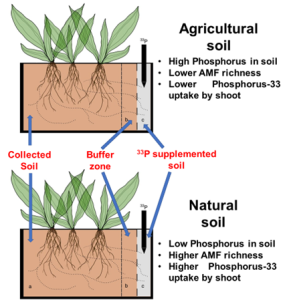 Are modern agricultural practices good for the environment? Or at least for the crops? If we look at a small field at a particular time point, it may seem they are good. But looking at a broader picture gives a different notion. In a recent study, Edlinger et al. collected 210 soil samples from traditional cropland (agricultural soil, AS), and nearby natural grassland (natural soil, NS) from five European countries. The authors analyzed soil and also looked for phosphorus (33P) uptake by the same plant species on different soils. They observed that although on average P level in NS is less than that of AS (likely due to P supplementation in AS previously), plants that grow in NS recover more 33P from a distal 33P source. This is because of higher species richness, especially arbuscular mycorrhizal fungi (AMF) richness, in NS. 33P recovery is directly proportional to AMF richness, both of which decrease with an increasing number of fungicide application. Overall, the study shows that “the capacity of AMF to support plant P nutrition is impaired in croplands compared with non-cropped grasslands, particularly by the use of fungicides“. Summary by Kamal Kumar Malukani, @KamalMalukani. Nature Ecol. Evol. 10.1038/s41559-022-01799-8.
Are modern agricultural practices good for the environment? Or at least for the crops? If we look at a small field at a particular time point, it may seem they are good. But looking at a broader picture gives a different notion. In a recent study, Edlinger et al. collected 210 soil samples from traditional cropland (agricultural soil, AS), and nearby natural grassland (natural soil, NS) from five European countries. The authors analyzed soil and also looked for phosphorus (33P) uptake by the same plant species on different soils. They observed that although on average P level in NS is less than that of AS (likely due to P supplementation in AS previously), plants that grow in NS recover more 33P from a distal 33P source. This is because of higher species richness, especially arbuscular mycorrhizal fungi (AMF) richness, in NS. 33P recovery is directly proportional to AMF richness, both of which decrease with an increasing number of fungicide application. Overall, the study shows that “the capacity of AMF to support plant P nutrition is impaired in croplands compared with non-cropped grasslands, particularly by the use of fungicides“. Summary by Kamal Kumar Malukani, @KamalMalukani. Nature Ecol. Evol. 10.1038/s41559-022-01799-8.
Drought-induced civil conflict among the ancient Maya
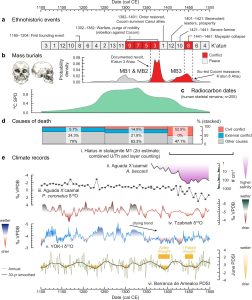 The observation that “Those who cannot remember the past are condemned to repeat it,” (attributed to philosopher George Santayana) is quite relevant for our efforts to comprehend the impacts of climate change. As we observe temperature and rainfall records being broken with increasing frequency, it remains difficult to know where things are headed, but at the same time it’s important to be aware of where things could go. Without doubt, climate change can lead to social instability, and we can look to the past to see examples of this, as illustrated in a new article by Kennett et al. that draws on an interesting blend of history and science. Specifically, they looked the collapse of the Postclassic Maya capital of Mayapan (1200–1450) on the Yucatán Peninsula (Mexico). This in-depth study pinpoints the influence of prolonged drought as a driver of social conflict, lending weight to the current drive to address climate instability for future social stability. One of the most interesting parts of reading this paper for me, as a non-expert, is the variety of data that these researchers used to draw this conclusion. How does one estimate population? Radiocarbon dating of skeletons: the number skeletons of a certain age reflects the size of the population. How to measure conflict? A high incidence of human remains with “embedded arrowheads, stabbing wounds or blunt force trauma to the skull.” How to measure drought? Obviously tree rings can be used, but another interesting method applied here is to measure the rate of growth of stalagmites (more water = faster stalagmite growth rate). It’s a fascinating multidisciplinary research paper, which you can also read about here https://phys.org/news/2022-07-climate-civil-unrest-ancient-maya.html and here https://phys.org/news/2022-07-climate-conflict-collapse-drought-destabilized.html. (Summary by Mary Williams @PlantTeaching) Nature Comms 10.1038/s41467-022-31522-x.
The observation that “Those who cannot remember the past are condemned to repeat it,” (attributed to philosopher George Santayana) is quite relevant for our efforts to comprehend the impacts of climate change. As we observe temperature and rainfall records being broken with increasing frequency, it remains difficult to know where things are headed, but at the same time it’s important to be aware of where things could go. Without doubt, climate change can lead to social instability, and we can look to the past to see examples of this, as illustrated in a new article by Kennett et al. that draws on an interesting blend of history and science. Specifically, they looked the collapse of the Postclassic Maya capital of Mayapan (1200–1450) on the Yucatán Peninsula (Mexico). This in-depth study pinpoints the influence of prolonged drought as a driver of social conflict, lending weight to the current drive to address climate instability for future social stability. One of the most interesting parts of reading this paper for me, as a non-expert, is the variety of data that these researchers used to draw this conclusion. How does one estimate population? Radiocarbon dating of skeletons: the number skeletons of a certain age reflects the size of the population. How to measure conflict? A high incidence of human remains with “embedded arrowheads, stabbing wounds or blunt force trauma to the skull.” How to measure drought? Obviously tree rings can be used, but another interesting method applied here is to measure the rate of growth of stalagmites (more water = faster stalagmite growth rate). It’s a fascinating multidisciplinary research paper, which you can also read about here https://phys.org/news/2022-07-climate-civil-unrest-ancient-maya.html and here https://phys.org/news/2022-07-climate-conflict-collapse-drought-destabilized.html. (Summary by Mary Williams @PlantTeaching) Nature Comms 10.1038/s41467-022-31522-x.



